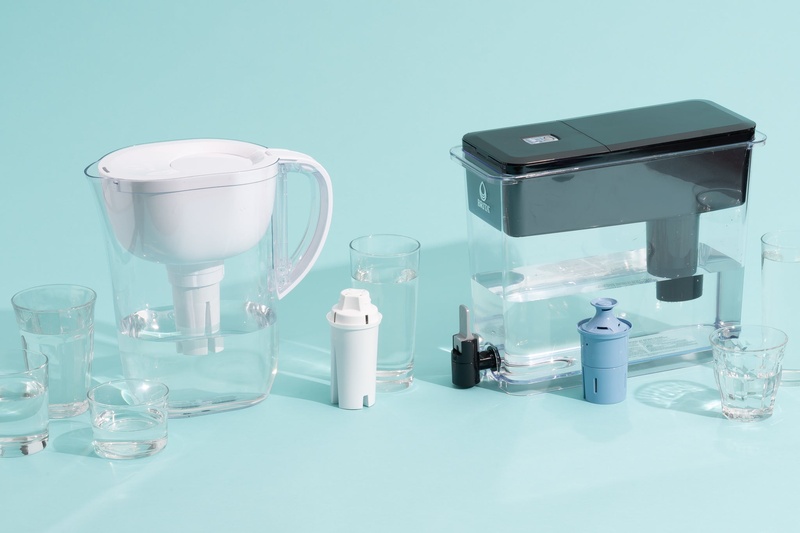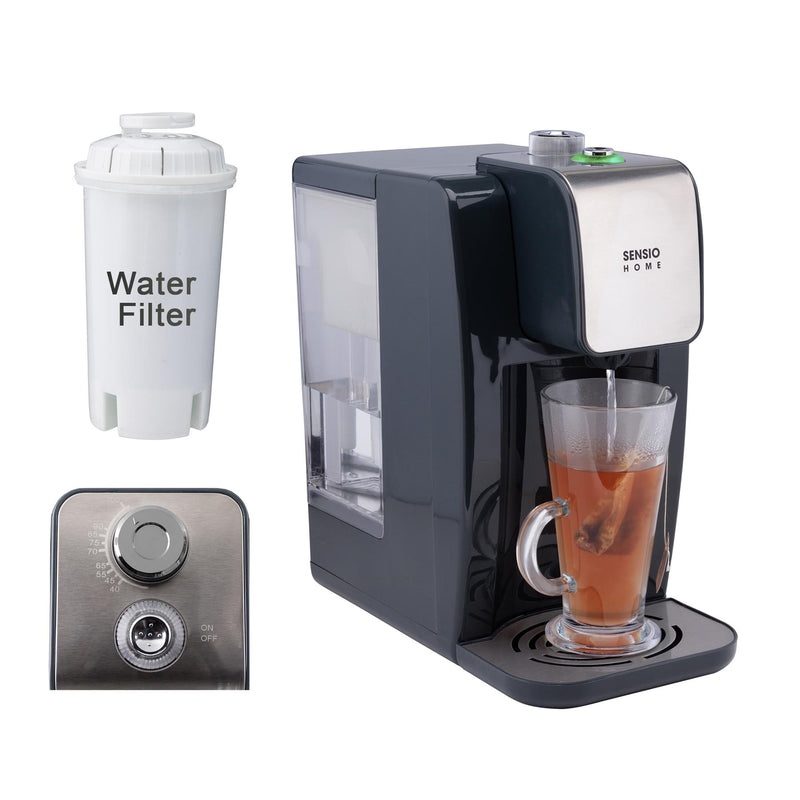When it comes to accessing clean drinking water at home or in the office, water dispensers and water filters are two popular options with distinct features and benefits. Water dispensers provide convenient access to temperature-controlled water, while water filters focus on removing contaminants from tap water. Though they both aim to improve your drinking water experience, they serve different primary functions and suit different needs. Understanding the key differences between these two solutions can help you make an informed decision based on your specific requirements, living situation, water quality concerns, and budget considerations.
A water dispenser is an appliance that provides easy access to drinking water, typically offering different temperature options including cold, room temperature, and hot water. These devices come in various configurations to suit different spaces and needs.
Water dispensers generally fall into two main categories: bottled water dispensers and point-of-use (POU) dispensers. Bottled models require regular replacement of large water bottles (usually 3-5 gallons), while POU dispensers connect directly to your water line, eliminating the need for bottle replacement.
Most modern water dispensers feature user-friendly push-button or lever-operated dispensing mechanisms. Premium models may include additional features such as self-cleaning functions, child safety locks, night lights, and even basic filtration systems.
- Top-loading bottle dispensers (most economical)
- Bottom-loading bottle dispensers (easier bottle replacement)
- Countertop dispensers (space-saving)
- Freestanding floor models (larger capacity)
- POU dispensers (no bottles required)
Content Navigation
What is a Water Filter?

A water filter is a device designed to remove impurities, contaminants, and unwanted substances from water through physical, chemical, or biological processes. The primary purpose of water filters is to improve water quality and taste by removing chlorine, lead, bacteria, parasites, and other potentially harmful substances.
Water filters utilize various filtration technologies, often in combination, to target specific contaminants. Common filtration methods include activated carbon, ion exchange, reverse osmosis, UV purification, and mechanical filtration. Each technology addresses different water quality issues with varying degrees of effectiveness.
Call 888-896-7031 for Free Local HVAC Quotes – Compare and Save Today!
Common Types of Water Filters
- Pitcher filters – portable containers with replaceable filter cartridges
- Faucet-mounted filters – attach directly to existing faucets
- Under-sink filters – installed beneath the sink with a dedicated dispensing faucet
- Countertop filters – connect to faucets with a diverter valve
- Whole-house filtration systems – filter water throughout the entire home
- Reverse osmosis systems – use semipermeable membranes for advanced filtration
Key Differences Between Water Dispensers and Water Filters
The fundamental difference between water dispensers and water filters lies in their primary function and purpose. Water dispensers focus on convenient access and temperature control, while water filters prioritize purification and contaminant removal.
| Feature | Water Dispenser | Water Filter |
|---|---|---|
| Primary Function | Convenient dispensing and temperature control | Contaminant removal and purification |
| Water Source | Pre-packaged bottles or direct water line | Existing tap water |
| Temperature Options | Usually offers cold, room temperature, and hot water | Generally provides room temperature water only |
| Filtration Capability | Limited or basic filtration (if any) | Primary purpose with various filtration technologies |
| Space Requirements | Requires dedicated floor or counter space | Various options from compact to hidden installations |
| Power Requirements | Typically requires electricity for cooling/heating | Most require no electricity (except UV or RO systems) |
Comparing Functionality and Usage

Water dispensers excel in convenience and accessibility, making them ideal for high-traffic areas where multiple people need frequent access to drinking water. They eliminate the need to wait for water to cool in the refrigerator or heat up on the stove, providing instant temperature-controlled water.
Water filters focus on improving water quality rather than convenience of access. They integrate with your existing water supply, addressing specific contaminants that might be present in your tap water. While they don’t offer the temperature control of dispensers, they provide peace of mind regarding water purity.
Ideal Use Cases
Water dispensers are particularly well-suited for:
- Office environments and waiting rooms
- Homes without reliable or good-tasting tap water
- Households that frequently use hot water for tea, coffee, or instant foods
- Situations where water needs to be accessible to many people
Water filters are better for:
- Homes with specific water quality concerns (e.g., chlorine taste, lead, etc.)
- Environmentally conscious households looking to reduce plastic bottle usage
- Integrating purification into existing kitchen setups
- Addressing particular health concerns related to water contaminants
Cost Comparison
The financial considerations for both options extend beyond the initial purchase price. When evaluating costs, it’s important to consider both upfront investment and long-term expenses.
Call 888-896-7031 for Free Local HVAC Quotes – Compare and Save Today!
| Cost Factor | Water Dispenser | Water Filter |
|---|---|---|
| Initial Purchase | $100-$500 for quality models | $20-$1,500 depending on type and complexity |
| Installation | Minimal for bottled; $100-$200 for POU models | DIY for basic filters; $150-$500 for complex systems |
| Recurring Costs | $5-$15 per bottle plus electricity ($50-$100/year) | Filter replacements ($30-$200/year) |
| Maintenance | Cleaning supplies and occasional repairs | Minimal beyond filter replacements |
| 5-Year Estimated Cost | $1,200-$2,500 (bottled); $600-$1,200 (POU) | $250-$500 (basic); $1,000-$2,500 (advanced systems) |
Bottled water dispensers tend to have higher long-term operational costs due to continuous bottle purchases, while point-of-use dispensers and filters typically cost more upfront but less over time. Whole-house filtration systems represent the highest initial investment but provide comprehensive coverage.
Maintenance Requirements
Proper maintenance is essential for both water dispensers and filters to ensure optimal performance, longevity, and water quality. The maintenance needs differ significantly between the two options.
Water Dispenser Maintenance
Water dispensers require regular cleaning and sanitization to prevent bacterial growth and mineral buildup. Bottled water dispensers need particular attention to the bottle receptacle area where water is exposed to air.
- External surfaces should be wiped down weekly
- Internal components should be sanitized every 3-6 months
- Drip trays should be emptied and cleaned regularly
- Temperature controls may need occasional recalibration
- Water bottles should be properly stored to prevent contamination
Water Filter Maintenance
The primary maintenance requirement for water filters is timely filter replacement. Neglecting to change filters can lead to reduced effectiveness and potentially worse water quality than unfiltered water if bacteria begin growing in the old filter media.
- Pitcher filters typically need replacement every 2-3 months
- Faucet-mounted filters: every 2-3 months or 100-200 gallons
- Under-sink carbon filters: every 6-12 months
- Reverse osmosis membranes: every 2-3 years
- Sediment pre-filters: every 3-6 months
Health and Environmental Considerations
Both water dispensers and filters have implications for health and the environment that extend beyond their basic functions. These factors may influence your decision based on personal priorities.
Health Aspects
Water filters generally offer more comprehensive contaminant removal, targeting specific substances like lead, chlorine, pesticides, and some microorganisms. The effectiveness varies widely based on the filtration technology, with reverse osmosis systems providing the most thorough purification.
Water dispensers primarily rely on the quality of the water source they use. Bottled dispensers depend on the bottled water quality, while POU dispensers provide whatever water quality comes through your pipes, unless they incorporate filtration systems. The main health concern with dispensers is potential bacterial growth if not properly maintained.
Environmental Impact
From an environmental perspective, water filters generally have a smaller ecological footprint than bottled water dispensers. The production, transportation, and disposal of large plastic water bottles contribute significantly to plastic waste and carbon emissions.
Point-of-use dispensers and water filters both reduce reliance on single-use plastics. However, filter cartridges themselves create waste, though some manufacturers now offer recycling programs. Reverse osmosis systems can waste water during the filtration process, with some systems discarding 2-4 gallons for every gallon produced.
Which Option is Right for You?
Choosing between a water dispenser and a water filter depends on your specific needs and priorities. Consider these factors when making your decision:
- Water quality concerns: If you have specific contaminants to address, a targeted filter may be best
- Convenience needs: If instant hot/cold water access is important, a dispenser offers advantages
- Space availability: Limited counter or floor space may favor certain filter types or compact dispensers
- Budget constraints: Consider both upfront and long-term costs based on your usage patterns
- Environmental priorities: POU dispensers and filters generally have lower environmental impacts
- Maintenance willingness: Consider how much maintenance you’re willing to perform regularly
Many households find that a combination approach works best—using a water filter for drinking and cooking water, while maintaining a simple dispenser for convenient access or temperature control. This hybrid solution can address both quality concerns and convenience needs while managing costs effectively.
Tips for Getting the Best HVAC Prices
- Prioritize Quality Over Cost
The most critical factor in any HVAC project is the quality of the installation. Don’t compromise on contractor expertise just to save money. - Check for Rebates
Always research current rebates and incentives — they can significantly reduce your overall cost. - Compare Multiple Quotes
Request at least three estimates before making your choice. You can click here to get three free quotes from local professionals. These quotes include available rebates and tax credits and automatically exclude unqualified contractors. - Negotiate Smartly
Once you've chosen a contractor, use the proven strategies from our guide — How Homeowners Can Negotiate with HVAC Dealers — to get the best possible final price.

